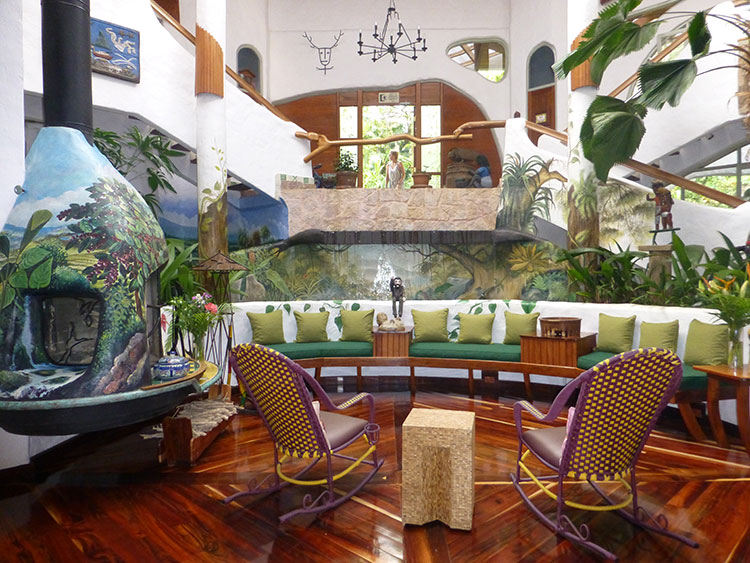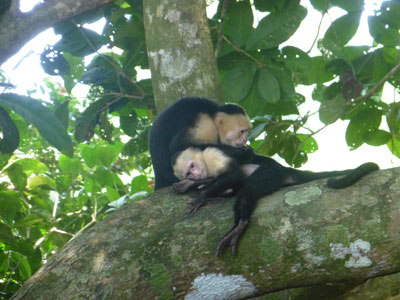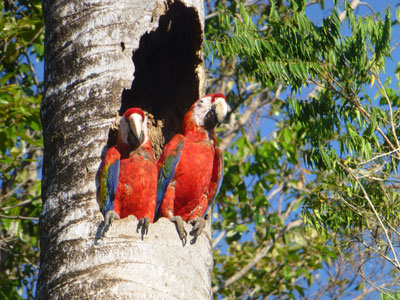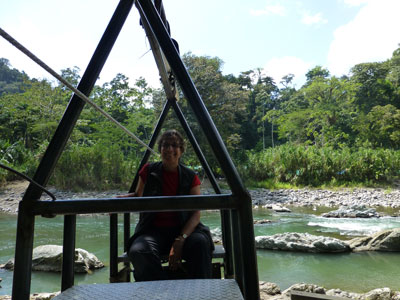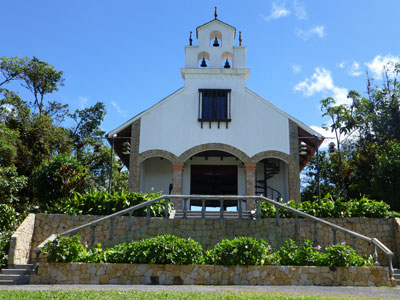Monkeys, macaws and a multitude of outdoor adventure on an ecotour of Costa Rica
This article appears on page 32 of the December 2013 issue.
Nili Olay; New York, NY
The travel bug bit me again this year, so, with my husband’s concurrence, I began planning a 4-month-long trip (February to June) in warm international locations. We looked at a number of options and decided on Central America — Costa Rica and Panama for ecotourism and Mexico and Guatemala for history and culture — with a small-boat cruise thrown in sometime during that trip.
We didn’t have the time to research and put together our own multicountry trip, but finding a travel agent to put together a leisurely custom trip of this length proved a bit of a challenge.
Most companies we contacted tried to sell us a combination of their canned trips and could do only one or two countries but not all four. Friends recommended Fred Del Pozzo of Tzell Travel Group (New York, NY; 212/944-2121, ext. 2225).
Fred saw our request as a fun challenge and arranged a really great trip using three Central American tour companies plus Windstar Cruises for the transfer from Costa Rica to Panama through the canal.
This article will focus on the Costa Rica portion of the trip.
The plan
Under Fred’s direction, Memorable Costa Rica (Rockville, MD; 301/217-0158) recommended locations and hotels. We paid $24,800 for our 50 days in Costa Rica, which included hotels, transportation, some guided tours, daily breakfast and some lunches and dinners.
Although not awash in culture or history, Costa Rica is a perfect place for an ecovacation. There are many national parks and private reserves, havens for birds and animals. English is widely spoken in tourist areas, tap water is generally safe to drink, and dollars are as acceptable to vendors as colones.
Costa Rica is not a large country, yet it has many microclimates and terrains. With seven weeks at our disposal, we had ample leisure time to see the volcanoes, the cloud forests, the jungle and the Caribbean and Pacific beaches.
Transportation in Costa Rica was difficult, since reaching most of the remote lodges required traveling on rocky, curvy dirt roads at a maximum speed of 20 miles per hour or flying in on a small plane. With travel days being difficult, we were glad that we had a week each at most locations.
Since we didn’t have a car at our disposal and most of our accommodations were in fairly remote locations, we ate the majority of our meals at our lodges.
At Pacuare and Lapa Rios, we were on a full meal plan. At other lodges, we could have taken a taxi to town or to another restaurant, but it was more cost effective and convenient to eat at the hotel.
The lodge’s meal choices were mostly in the range of $6 to $8 for appetizers, $10 for sandwiches and $15 to $20 for main courses. Breakfasts were included at each accommodation.
In the clouds
On Feb. 1, a cold day at the Newark airport, we embarked on our adventure. We landed in San José, Costa Rica, and were spirited away by our driver to Villa Blanca, located in the cloud forest, for four nights. It was a perfect place to start.
The lodge, a 1½-hour drive from San José, was at the top of a hill. Since the sky was clear when we arrived, we could see the beautiful valley surrounding the resort.
The main house had many charming sitting areas, both downstairs and upstairs, plus an open-air dining room and a theater for watching movies. Our cabin, with a fireplace, two rocking chairs and a patio with a table and chairs, was a delight.
In the evening, the mist would roll in. Each day was misty for at least part of the day and sunny for a few hours as well. According to the hotel staff, mist is more likely than sun. It was chilly — about 60°F when misty and a bit warmer when in the sun.
The hotel offered a number of tours for an extra fee, but they were expensive (most over $100 per person). The only tour we took was a day trip to Sarchí ($75 each), a town that specializes in painted ox wagons. The factory is still operating but now makes souvenirs.
We spent the rest of our time on the hotel grounds, walking the trails, watching hummingbirds at the feeder, milking a cow and visiting darling little Mariana Chapel. This church, built by former president Rodrigo Carazo for his wife, contains 840 painted ceramic tiles.
River to sea
Just getting to our next accommodation, Pacuare Lodge, was half the fun. We rafted on white-water rapids (levels 1 to 3) for two hours. We each were limited to a small bag, which we took on the raft with us, and we left the rest of our luggage at the lodge’s locked warehouse.
Pacuare Lodge is the epitome of an ecolodge — no electricity, no phone service, and cabins in the jungle with lots of privacy and comfortable patios. The cabins each have screens instead of walls, an outdoor as well as indoor shower and no locks on the doors.
Each morning, the unearthly sound of howler monkeys and the songs of birds woke us at 5 a.m.
There were a number of activities offered. We took a guided hike to a waterfall and an early-morning bird-watching excursion (both included in our travel package). We also hiked on our own and relaxed on the veranda overlooking the Pacuare River.
Each night we walked back to the cabin by flashlight to be greeted by a candlelit cabin and the sounds of the river.
After four wonderful days at the river, we moved on toward the Caribbean coast. Since rafting out was on level-4 rapids, we chose to take the van. First we climbed into a basket to cross the river, then we drove on a very bumpy road for about 1½ hours to the warehouse to collect our luggage. From there we continued on paved roads to Shawandha Lodge, 45 minutes south of Puerto Limón and three miles south of Puerto Viejo.
Puerto Viejo had the feel of a typical Caribbean town, with many restaurants and souvenir stores, a bank, pharmacies and a post office.
One visit to town by taxi ($9 each way) sufficed for us. We spent the rest of the time enjoying the beach and the lodge environment.
Shawandha Lodge is surrounded by jungle. Our ample cabin had electricity, a ceiling fan and lots of screened windows but no air-conditioning. The open-air dining area was very attractive and comfortable for both eating and relaxing.
The beach was across the street and a quarter-mile walk down a trail. The little walk was well worth it because the beach was picturesque, with the jungle coming right down to the shore. The water was warm and the surf, gentle.
The hotel provided beach towels, but there were no chairs or umbrellas. However, there was enough natural shade to make sitting on the beach very pleasant.
We ate our first dinner at the lodge, but we ate most of our meals at nearby restaurants, all within walking distance. I recommend Pita Bonita (phone 506 2756 8173) in Punta Uva, a half mile south of Shawandha. It is a Middle Eastern restaurant run by an Israeli-American couple. The food was outstanding, especially the eggplant. Salads ran $3 to $4 and main courses cost $10 to $12.
A half mile north of the lodge was another excellent restaurant, Pura Gula (phone 506 8634 6404). We had a great pizza for $12 that would have fed four. We also ate dinner there one night, fresh-caught fish for $16. The grocery store was next door to Pura Gula, and we often bought light food there to have for lunch.
I also highly recommend a tour of the Chocorart chocolate plantation (phone 506 8866 7493), just a quarter mile south of Shawandha Lodge. The tour cost $22 per person and included a walk through the plantation, a demonstration of the chocolate-making process and tastings. If you don’t have time for the tour, at least stop at the Chocorart store on the road for a fantastic hot chocolate ($2 a cup).
Arenal Volcano
Getting from Puerto Viejo to Tabacón Resort would have been a very long day’s drive, so the tour company arranged for us to fly from Puerto Limón to La Fortuna, 15 minutes from Tabacón.
We didn’t realize that this was a private taxi flight and were concerned that the tour company had arranged our car pickup only 45 minutes from flight time (which is how long it takes to go from Shawandha Lodge to Puerto Limón). When I questioned our contact, she laughed and said that we would be on time or the plane would wait.
There were no security lines and no check-in. Our plane arrived right on time; we boarded and were off.
It was a perfectly clear day and the flight was unbelievably exciting. We saw every volcano between the Caribbean coast and La Fortuna.
When we landed, the pilot said that he rarely saw Arenal bare of clouds and only very rarely in a cloudless sky. Only about 30% of visitors see any part of the mountain, much less the whole thing.
By the afternoon the clouds surrounded Arenal and, although we saw parts of the volcano during our stay, we never again saw the entire mountain.
Tabacón Resort had magnificent hot springs, and guests of the hotel could go there anytime during the day or evening either by foot (5-minute walk) or van. Non-hotel guests had to pay a fee ($60) to use the hot springs. We spent a couple of days trying out the many hot pools and especially loved the shady cabanas offering views of Arenal, clouds permitting.
We booked two tours through the hotel’s tour desk. The “Arenal Volcano” 2½-mile round-trip hike ($50 per person) followed a flat terrain, with a steep climb on volcanic rock for the last 50 meters. The climb was well worth it, as it allowed for a great view of one of the volcano’s craters and of Lake Arenal.
The “Hanging Bridges” 2-mile hike ($70 per person) was vigorous but not difficult. We crossed many swinging bridges and hiked in mid-elevation forest, which enabled us to watch howler monkeys at eye level. Most exciting was seeing a tiny poisonous snake curled in a tree.
Although we were glad we stayed at Tabacón because of its proximity to the hot springs, it felt like a 5-star hotel and lacked the ambiance of an ecolodge. With its hermetically sealed rooms, we could not hear the birds or the monkeys in the morning.
Monteverde
From Tabacón we made the long journey to Monteverde. We took a shuttle van to a boat, cruised on Lake Arenal for about an hour, then rode in another van for 1½ hours on very bumpy roads.
It was a relief to arrive at the charming Monteverde Lodge, which offered great spaces to relax, lovely grounds and the hope of seeing wildlife. (We were warned not to leave our patio doors open because monkeys might come in and cause havoc.) Most delightful was soaking in the Jacuzzi in a sunlit room at the end of the day.
The lodge was a 10-minute steep walk from town.
We booked a tour of the Monteverde Cloud Forest Reserve through the lodge for $70 per person. The reserve limits visitors to 150 at a time, so our tour group of nine people left at 7 a.m., driving the 15 minutes to the reserve. Unfortunately, we didn’t beat the crowds, since many other tour groups left early as well.
Our guide had a large spotting scope through which we viewed animals and birds high in the trees. Most fun was watching a troop of spider monkeys leaping from tree to tree with babies on their backs or stomachs.
We ended the tour at the hummingbird house, where a number of sugar water feeders were hanging from trees to attract the birds. (Monteverde has some 50 species of hummingbirds.) The birds were enjoying the treat, but one feeder was being monopolized by an oligo (squirrel-like animal), which was hanging upside down to get at the sugar water.
As an alternative to the 70-dollar tour, you can take the public bus for $2 from town (check the current schedule by calling 8811 8902) and pay just $17 for a day ticket to the reserve. But don’t expect to see much wildlife on your own; the guides and their scopes are well worth the price.
Since our ticket was good for the day, we stayed, had lunch and took another hike on our own before riding the bus back into town.
The next day we took a tour of the Monteverde cheese factory ($12 per person). Quakers from Alabama went to Costa Rica in the 1950s to escape the Korean War draft. They farmed and started the cheese factory as a way to use the milk produced. The factory tour was very interesting.
We also visited the Butterfly Gardens. The tour ($15 per person) included four different microclimate butterfly houses and a “bug” room. A knowledgeable guide took us through the facility.
We had an extra bonus while waiting for the tour to start: a troop of white-faced capuchin monkeys frolicked in the trees across the road.
Manuel Antonio National Park
The ride from Monteverde to Manuel Antonio National Park began on stony, unpaved, curvy mountain roads. Luckly, that lasted for only 45 minutes. The rest of the trip (three hours) was on paved roads.
We stayed at the beautiful boutique La Mansion Inn. Our room had a private patio with a view of the picture-perfect Manuel Antonio beach, a 15-minute ride away. A hotel van goes to the beach daily at 9, 11, 3 and 5, returning 15 minutes later. A taxi costs only $8, so flexibility can be bought fairly inexpensively.
We spent three days lounging on the beach, taking the van down at 9 a.m. and a taxi back after dinner. We rented two chairs and a cabana for $20 and felt that the shade was worth it. For $10 you can rent an umbrella rather than a cabana.
The water was warm, and the surf was usually calm enough for swimming.
The main area attraction is Manuel Antonio National Park. As in Monteverde, entry is limited (800 people per day on weekends, 600 during the week). It felt very crowded because all the groups took the same path. However, since there were only eight in our group (booked through the hotel for $48 per person), we could view wildlife through the guide’s scope fairly quickly. We saw white-faced capuchins, howler monkeys, 2- and 3-toed sloths and lots more.
We stayed and hiked on our own after the guided tour. If we had thought ahead, we would have brought our bathing suits and gone swimming at the end of the hike. The beaches inside the park were beautiful.
There were lots of great meal choices in the area. On beach days we ate at restaurants just across from the beach. We liked Italy & Co. for pizza ($11 for two people) and excellent ice cream ($2 per scoop). We also liked Dragonfly Thai, where appetizers cost $6 to $7 and main courses, $10.
Up on the hill between the beach and our hotel were a number of restaurants. We walked to El Avión from the hotel to watch the sunset and eat dinner. The meal was unremarkable, but the ambiance was lovely.
On our walk to the restaurant we ran across a troop of howler monkeys crossing the road on the blue wires that the town had strung above the road for them. There they were, right in front of us, rewarding us for our decision to walk.
Nicoya Peninsula
We stayed at two beach resorts on the Nicoya Peninsula: Punta Islita and Tango Mar. Both were great but for different reasons. Islita was a beautiful resort with a stunning view of the ocean from the dining room. Our private patio, not visible from any other cabin, had a Jacuzzi, comfortable chairs and a view of the ocean.
The main part of the resort was located about 200 stairs up from the beach, but guests could either walk or ask for the van, which operated on demand. The beach area was lovely, with a restaurant, a pool and a pool bar. Lunch could be ordered right from the lounge chairs.
Islita was a perfect place to just relax and feel pampered. The food and service were top-notch. Unfortunately, the surf there was a bit rough for me.
Tango Mar, about 2½ hours away, was not as fancy or as pampering, but there were more activities available there. We visited the Curu Wildlife Refuge, arriving by boat for a jungle hike and snorkeling ($75 per person, including park entry).
We also went on a separate, longer snorkeling trip ($65); the snorkeling was excellent, and we swam with large schools of fish. We spent a lot of time sitting on the beach, reading and walking on the grounds, but we couldn’t swim because of the strong surf.
The Osa Peninsula
Getting to Puerto Jiménez from Tango Mar was an adventure in itself. We were scheduled to fly Nature Air from the Tambor airstrip, 15 minutes from Tango Mar, but the airstrip was closed by the government for repairs a day before our flight.
The flight was moved to Javilla “airport,” which was 1½ hours away and involved wading across three rivers.
Our driver served as the ground crew at the airstrip. He weighed our bags and us, gave us boarding passes, guided the plane to a stop, etc. We changed planes in San José and flew on another small plane to Puerto Jiménez.
Lapa Rios, a 25-minute drive from Puerto Jiménez, was a fabulous ecolodge. They take their eco status seriously, recycling whatever is possible either by composting or feeding leftover food to the pigs and processing the manure to produce methane, which is used for cooking. Guests can take the “Pigs, Twigs and Garbage” tour to learn more about it.
The lodge offers many complimentary hikes and adventures. We went on two great hikes in primary and secondary forest, where we saw lots of birds as well as howler, spider, squirrel and white-faced capuchin monkeys. We also went on an early-morning birding hike.
The cabins were screened (no air-conditioning), and the howler monkeys and birds woke us up each morning at about 5 a.m. Our patio overlooked the ocean, and we spent the afternoon watching scarlet macaws flying. One afternoon, we watched spider monkeys jumping around in the trees.
We were very pleased that our last stop was the 15-room boutique hotel Finca Rosa Blanca, just outside San José. We spent three delightful days there, going on their coffee plantation tour ($35) and a half-day tour to Poás Volcano ($50).
While Arenal is a triangular volcano, Poás has collapsed and now has two crater lakes at the top: an older lake that is cold and another that is hyperacidic and still steaming.
We had a terrific guide on this tour, Keilor Carvajal (phone 506 8331 3504, email keilorcarva@hotmail.com). I recommend using Keilor, a freelance guide, if you are in the San José area.
Finca Rosa is centrally located, so if you have limited time in Costa Rica, it would be the perfect base for many day trips. Our suite was roomy and the public areas were charming.
If I were to do it over again, I would recommend slight changes to our itinerary: five nights at Pacuare, four at Monteverde and seven at Lapa Rios instead of four, three and five, respectively. I would also reduce our Tango Mar stay to four nights. However, seven weeks in Costa Rica was not a day too long.

